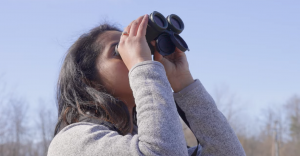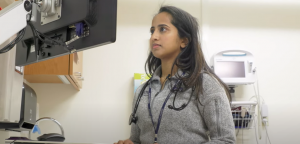Birdwatching is more than just a hobby for UConn School of Medicine student
Birdwatching is more than just a hobby for UConn School of Medicine student ()
It's a Wednesday in mid-February, and while the air still holds tight to the chill of winter, the warm sun is shining brightly as Maria B. Antony '19 (CLAS/CAHNR) walks slowly along the paved pathway around the pond at the lower campus of UConn Health.
Not far from the critical bustle of the hospital, as traffic stops-and-goes through the intersection at the nearby campus entrance on Farmington Avenue, Antony is watching the brush line near the water closely for a telltale sign - a wave of a branch, a rustle of dry leaves, a flutter of feathers.

"Typically, I'll scan by naked eye," she explains, a small pair of black binoculars dangling around her neck.
"I'll just look at what's around me. If you're on a body of water, you scan the body of water. Then, you start to move upwards, so that you don't miss anything."
On this morning, we're looking for birds, and in our short time out near the pond, a rowdy and unmistakable band of Canada geese dominate the landscape.
But Antony quickly points out the other, quieter birds she spots - like a pair of mallards, one a brilliantly iridescent green male and the other a mottled brown female, their bright orange feet clearly visible even from the opposite bank, and their quacks occasionally audible over the squawking and honking and splashing of the geese in the water.
A flock of shiny black grackles flits to-and-fro.
A group of vultures make a brief appearance, circling above The Jackson Laboratory.
And though we can't see the bird itself, we hear the song of a cardinal somewhere in the surrounding trees.
"Oh!" Antony suddenly calls out, an excited lilt to her voice. "We have a red-tail!" as a large and graceful hawk swoops out from behind the hospital tower.
She lifts her binoculars to her eyes to catch a closer glimpse of the bird. It lets out a shrill call and is quickly joined by another raptor, this time a more elusive red-shouldered hawk. We watch as the two large birds of prey circle each other, sparring in the air over the campus.
Moments later, a small bird flies right toward us, headed for a piece of deadwood in an area near the pond. Antony identifies it almost immediately not by how it looks, but by its distinctive up-and-down motion in flight - it's a woodpecker, a red-bellied woodpecker to be exact. Bigger than the downy woodpecker, she explains, but both species are smaller than the pileated woodpecker - those can be quite a stunning sight.
For a busy medical student, more than just a hobby
In an environment of pressure, with the demands of the hospital environment, under the constant glare of technology, nature is still all around us, Antony says - and watching the birds offers a tangible, easy, and mindful way to focus on the world beyond the realm of medicine.

"I think in medicine, and in many fields, there is this huge impact of burnout - in a medical career, even in the training of medical professionals - and the opportunity to go outside, take a moment to recenter, and really get focused in the present, it's there in really in any type of environment," Antony says. "You can be in Hartford, you can be here locally in Farmington, and still have some opportunity to find something."
Birdwatching is more than a hobby for Antony, who will graduate from UConn School of Medicine this spring - it was a lifeline for her during her medical training.
"Watching peregrine falcons nest from the large windows of a Connecticut hospital was my therapeutic diversion," she wrote in an article published by the BMJ in December. "Looking outside provided a pause for reflection, a chance to recalibrate. Birding connects us with the rhythm of the seasons and makes apparent the constancy and change in our shared ecosystem."
Antony started birdwatching nearly a decade ago, while she was still an undergraduate studying cell and molecular biology and allied health at UConn. She loved photography, and started a relationship with an avid birdwatcher - slowly, their hobbies merged.
Now engaged, their shared love of birdwatching has taken them on planned trips to Costa Rica in search of rare birds, as well as impromptu jaunts around the United States as part of an online community of birders who share sightings with each other through apps like eBird.
"More recently, our target was a short-eared owl that was in a community in Bloomfield - it was reported in a senior center," Antony says, so off they went. "January is when a lot of people's lists for the year restart, so everyone was out. You could see a whole community of birdwatchers out on that date in early January. So, we got short-eared owl for the year."
Medicine and birdwatching have more in common than you may think
Birdwatching and medicine aren't so different, according to Antony, who drew parallels between the two in her article for the BMJ - since its publication, she's heard from birdwatching doctors around the globe about their experiences and the parallels they've also seen between their practice and their birding.
"The history of medicine, in general, really started back in the Renaissance, where people started to look at things differently," Antony says. "There was more of a focus on this understanding of human anatomy, being descriptive and being accurate, and utilizing cadaver studies. Around that same time, a physician actually started the similar dissection of birds as well as the illustration of birds with anatomic detail that had some species-type information."
Both birdwatching and medicine require practitioners to use both sight and sound, she explains. Cardiologists listen to heard sounds to help make diagnostic determinations.
"Here in Connecticut, we have two species, American crow and fish crow," she says. "They're totally indistinguishable if you were to just look at them, but their calls have a very unique difference between the two. You really need to wait for the call to make that diagnostic determination."
In the same way that binoculars and scopes make it possible to view birds in their natural environments, tools like loupes and binocular vision are used regularly by dentists and surgeons in their practice.
"In the urology lab, there's endoscopes to look inside the bladder and get a really good idea of what is happening inside the bladder without any incisions, all minimally invasive," Antony says, "very similar to how we often take scopes out on bodies of water when birdwatching."
The use of technology in both birdwatching and urology practice is of particular interest to Antony - she was placed in a nephrology rotation early on in medical school and realized that she really liked it.
"You can, from a medical perspective, really change the trajectory and course of these patients' disease and ultimately avoid something as morbid as dialysis," she says. "From a surgery standpoint, I really liked that the surgeon can come in, particularly the urologist - say that someone has an obstructed kidney or some congenital malformation of their urinary tract -and they can intervene, and then see that improvement in kidney function on an acute level, and then follow through that across a lifespan."
Moving from medical school to residency – and new birding precincts
During her medical school training, she spent a year in Maryland at the National Institutes of Health Clinical Center through the Medical Research Scholars Program, where she primarily worked with patients with congenital kidney cancers, including von Hippel-Lindau disease, or VHL.
In those cases, she says, you're not only seeing the patient, but also their families - tracking the disease as it progresses through generations and seeing first-hand how medical and technological breakthroughs can change patient and family trajectories.
"Urology has really been at the forefront of endoscopic technology, as you can think of stones, lithotripsy, any type of viewing - you can use a camera to look in the bladder, and then more recently, flexible cameras can actually allow you to go from the bladder into the kidney," Antony says. "With robotic surgeries, urologists are at the forefront of adopting and adapting new technology that's emerged. Originally, the port system for the da Vinci robot was four or five ports. Now, there's a single port system that the urologists are moving forward at Hartford Hospital.
"The opportunity to work with new technologies is something that I find super interesting."
Antony will get to continue exploring new technologies as she moves into her first year of urology residency this coming July - the soon-to-be doctor and "double Husky" is heading to Ohio and a spot at the prestigious Cleveland Clinic's urology residency program, where she matched in early February.

And while she'll be relocating her backyard feeder, and saying goodbye to a beloved cormorant that sits on a post at the West Hartford reservoir - hailing the return of summer for her each year - she's already looking forward to finding new favorite places to spot birds in Ohio.
"I'm hoping I can make more stops by Magee Marsh," Antony says. "It's actually really good for warblers every year."
She mentions the warblers often - small songbirds that migrate to the northeastern part of the US from South America each year.
"They're very evasive when you're looking at them," she says. "It's tough to get an identifiable shot of them, from the photography standpoint. But if you are out there, you can probably see these very small birds. They jump from leaf to leaf. You'll see flashes of colors, all sorts of really beautiful colors."
She's already spotted the orange-crowned warbler in Connecticut - the first for her for the year, and the first one spotted in Hartford County in 2024.
She shared its location on eBird, for any other birdwatchers in her home state, or beyond, looking to mark it off their list.






